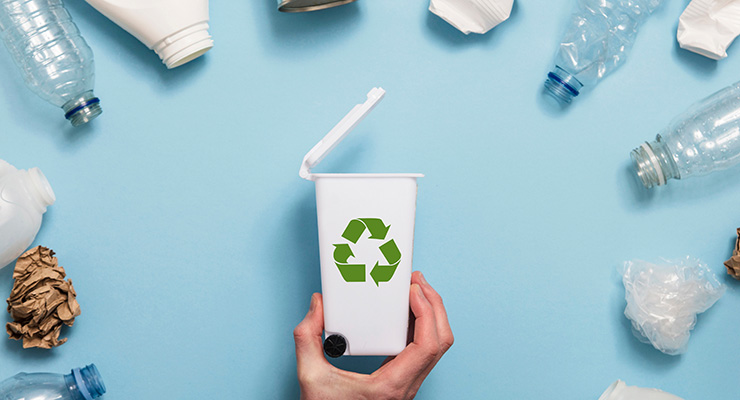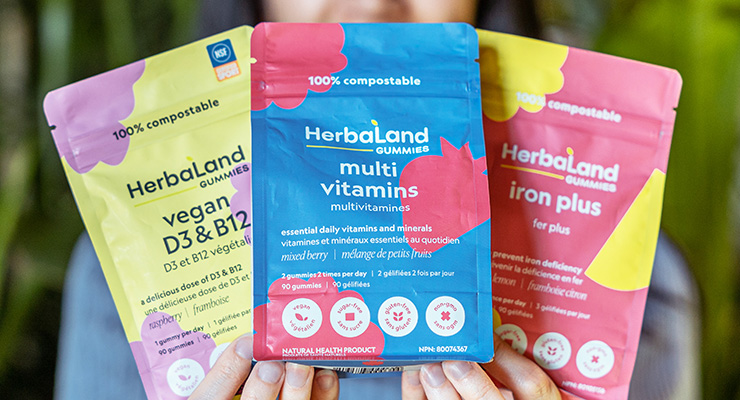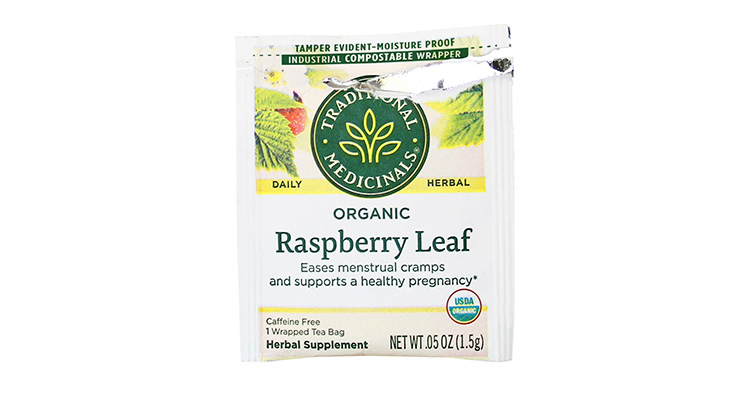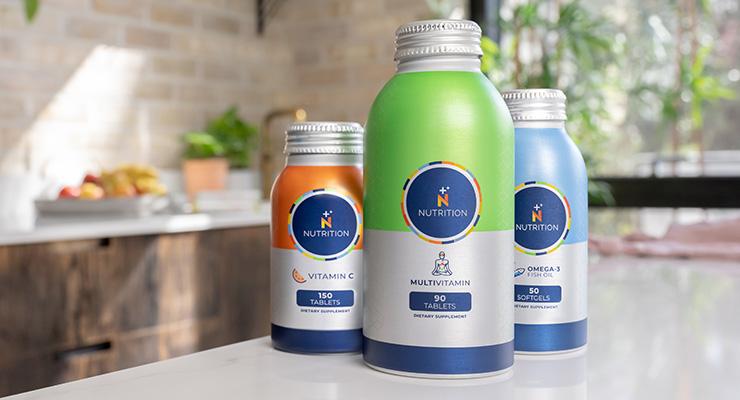Features
Addressing the Plastic-Packaging Problem: Getting to Zero-Waste with Zero Compromise
As brands commit to sustainability benchmarks, demand for more plastic alternatives is building.

By: Mike Montemarano

The end-to-end ecological impact of a product is among the top purchase drivers for consumers today. Brands and packaging producers are working in tandem to bring to market products with packaging that’s better for the environment but still able to protect sensitive ingredients from moisture, heat, oxygen, and light.
The overwhelming majority of dietary supplements are sold in plastic bottles, and brands may miss out on a huge opportunity if they aren’t in the race to zero waste. However, early adopters must contend with potential increased operating costs, limited availability of materials and services, and a lack of clear guidance on which next-gen packaging material is the most suitable for their products.
The Green Packaging Market
The nutraceutical packaging market consists of blister packs, bottles, jars, low-density polyethylene (PET), and high-density PET, cartons, stick packs, and more.According to Grand View Research, sales of green packaging for all industries in the U.S. reached $274.15 billion in 2020, anticipated to grow at a CAGR of 6.1% until 2028. Comparatively, the global packaging and protective packaging market was valued at just over $1 trillion in 2021 and is expected to grow at a CAGR of 4.3% until 2031.
A recent survey conducted by NIQ (formerly known as NielsenIQ) and McKinsey concluded that sustainability is becoming inextricable from the value of consumer packaged goods. The market study, which tracked 500,000 SKUs, found that over a 5-year period beginning in 2016, foods, beverages, dietary supplements, and other consumer products featuring a sustainability claim on-pack grew at a significantly greater CAGR than products without such claims. Unique claims that aren’t used abundantly had the highest impact overall, the study found. While shoppers care deeply about cost-saving, premium costs are not a significant purchase barrier. However, more value-focused private label brands saw the greatest growth related to their sustainability claims.
Another survey conducted by McKinsey in 2020 also concluded that consumers have a widespread willingness to pay more for a product housed in renewable packaging. Sixty to seventy-two percent of respondents told the company that they’d pay more for greener packaging, while 35-36% of respondents would buy additional sustainably-packaged products if they were more available and more clearly labeled. Consumers were equally interested in both recyclable and biodegradable packages, with slight variations depending on the product.
Consumer confusion is still a major issue. “The inclusion of criteria or a logo serves as an immediate reference,” Chris Schaefer, director of marketing for Earthfirst Films, said during a seminar at Natural Products Expo West in March 2023. “Over half of consumers say the sustainability of the packaging is a factor in their selection process, and at least 65% of consumers use labels or third-party certifications to determine if a product is environmentally friendly.”
Is Plastic Circularity A Dead End?
The U.S. and many other countries lost access to overseas plastic recycling infrastructure in 2018, when a ban on the importation of waste was enacted in China covering plastics that cannot be recycled in most U.S. facilities. Since then, domestic plastic recycling rates have been on a downward trajectory.According to a report by Greenpeace USA, based on a survey of curbside recycling facilities, the U.S. recycled only 4.7% of all plastics (2.4 million tons of 51 million tons produced), down from a high of about 9.5% in 2014. The report also noted that no type of plastic packaging in the U.S. meets the definition of recyclable, according to the Ellen MacArthur Foundation’s New Plastic Economy Initiative (EMF-NPE). EMF-NPE standards classify a plastic as “recyclable” if, in practice, that plastic achieves a 30% recycling rate. However, the most common plastics in the U.S., PET #1 and HDPE #2, fall well below that threshold.
A report by supplement company Terraseed found that 1.8 billion plastic supplement bottles are sold each year in the U.S. alone, and a large portion are packaged in secondary packaging, such as boxes, sachets, and plastic wrap. In total, 76% of supplement packaging today is made of plastic, the company reported.

Plastic Solutions for Today
With odds being slim that a post-consumer resin (PCR) package gets recycled a second time, organizations formed by the natural product industry such as One Step Closer advocate for a full phasing out of petroleum-based plastics in favor of a new generation of bio-based film structures.This shift won’t happen overnight. In the meantime, measures can be taken to increase the recyclability of a plastic package.
In response to a lack of widely-available circular infrastructure for plastics, legacy brands and emerging startups alike have been relying on internal recycling and refilling schemes.
“Challenges related to reuse or refill are generally business case-specific items such as logistics of collecting, cleaning, and redistributing a refilled container,” said Chas Aylsworth, business development manager, Trivium Packaging. However, the nutraceuticals space can likely take inspiration from products in the spirits industry, household and personal care products, and more.
On the supplements front, Desert Harvest made a commitment in 2022 to phase out all of its plastic supplement bottles, replacing them with a refillable, Bluetooth-enabled smart bottle which can track usage, push refill reminders, and more, diverting millions of plastic bottles from landfills.
Some brands are embracing minimalism as an option to reduce a company’s net impact on greenhouse gas emissions and waste volume. Wiley’s Finest, for example, announced in late March that it will eliminate its outer carton from its products, in order to divert over 1 million cartons annually.
“Brands are quickly becoming more aware and sustainability-conscious, and adjusting their packaging designs as a result,” Lori Bitar, product manager at FLEXcon, told Steve Katz, contributing editor of Label & Narrow Web (L&NW), a sister publication of NW. “This includes using small containers to reduce head space, and seeking more sustainable label substrates such as downgauged constructions, label materials, and containers made partially of post-consumer waste, and products that better facilitate recyclability.”
Brands switching to PCR packaging are salvaging virgin resins from being immediately placed in a landfill. Additionally, the U.S. Plastics Pact reported that PCR production can reduce energy consumption by 79% and reduce greenhouse gas emissions by at least 67% compared to using virgin resins.
At the beginning of 2023, NOW Foods began a rollout of switching its supplement bottles to 100% PCR resin. Aside from slight color variations, there were no differences in oxygen and water-vapor permeability or leaching, according to the company’s testing.
One of the biggest challenges for brands in search of more sustainable plastic is a lack of material availability, and it’s important to work with packaging providers that can be flexible amid shortages, Andrew Palmer, director of sales at RRD Label Solutions, told L&NW.
“If the past few years have taught us anything, it’s that conditions can change fast with sudden material shortages, rising costs, and unmet labor needs. It’s important to be flexible and prepared to help our clients source alternative materials, inks, embellishments, etc., whenever challenges arise while keeping products in brand specifications.”

Composting In Practice
Several brands have begun rolling out 100% compostable or recyclable packages for their products. Some rollouts have been for certain portions of a company’s portfolio, while other brands have launched with 100% compostable/recyclable packaging for every product.While objections to compostable packages exist due to concerns about performance, brands have spent several years or even decades undergoing R&D analysis.
Traditional Medicinals launched the first-ever BPI-certified compostable tea wrapper. BPI certification validates that a product undergoes compostability testing to ensure that it is suitable for compost alongside food scraps. Other “compostable” packages on the market often get diverted to landfills due to practical issues by most recycling programs.
“We’ve been working on compostable tea wraps since I joined the company, and the wraps are 10 years in the making,” said Taylor Clayton, sustainability impact manager at Traditional Medicinals. “It’s been a goal in each of our company’s impact reports since 2012, and we’ve had long debates over the right substrate to use, as well as whether we should take the route of compostable or recyclable. With all of this in mind, our top priority was that we did not compromise the medicinal quality of the herbs, and ensured that they stringently met [U.S. Pharmacopoeia] standards.”
The company conducted testing up to 6 months, and after pilot launches, pulled products from shelves in actual retail locations to test stability under real-world conditions, proving that the 6-month shelf life of the packaging would be applicable to all environments.
“Like quality certification, BPI certification was critical for us,” said Clayton. “Consumers are most trusting of sustainability claims that come from voluntarily meeting the standards of a third-party organization.”
In early April, Vancouver-based gummy-supplement specialist HerbaLand Naturals marked one year since the launch of its compostable packaging, and has already diverted an estimated 9 tons of plastic from landfills, the company said. This shift helped to earn HerbaLand B Corporation certification in October 2022, as well as the SEAL Environmental Initiative Award, which is earned by companies that show leadership, innovation, and commitment to sustainable business practices.
To complement the new packaging, the company also partnered with Veritree to plant one tree for every pouch sold. HerbaLand’s pouches are made from sustainably sourced wood pulp, cornstarch, cassava, sugarcane, and beets. The components of the pouches, including the zipper, conform to the OK Compost Home certification, which verifies that all packaging will fully break down into organic materials, rather than microplastics. The company also received a Pela’s Lomi Approved label, which approves compostable plastics for use in the Lomi compost machine.
Care/of also recently transitioned its vitamin packs to a plant-based film sourced from wood pulp and a fermented blend of corn, cassava root, and sugar cane. The specialty materials are specifically suited for composting facilities, unlike some plant-based plastics that require precise conditions to degrade in a way that doesn’t produce microplastics.

Metal: A Time-Tested and Versatile Option
Both aluminum and steel packages have withstood the test of time as a circular packaging material suitable for a variety of contents. Metal packaging specialists are continuing to work with novel supplement ingredients and formats to ensure this renewable packaging resource can remain applicable in today’s nutraceuticals market.Trivium Packaging, which specializes in steel and aluminum, is investing in capabilities for nutraceuticals, such as new shapes and sizes, child-resistant and other types of threaded closures, and straight-sided containers. The company is also adding second layers for tamper evidence without the need for secondary packaging. Another major investment is in graphical capabilities, and having the ability to print photo-realistic images directly onto bottles, said Aylsworth.
“When working with potentially difficult ingredients, Trivium partners with our customers to conduct stability testing in our state-of-the-art testing facilities in the U.S. and France,” said Aylsworth. “To meet the needs of these potentially difficult ingredients we have various internal coatings we apply to the bottles which allow numerous different product and package protection benefits along with the ability to tailor the package to the brand’s needs.”
Based on global recycling and material circularity rates, aluminum bottles are the most sustainable choice for nutraceuticals from a material standpoint, Aylsworth said. “There is a difference between what can be recycled and what actually is recycled at material recovery facilities (MRFs).”
One of the biggest variables is whether a consumer disposes of packages correctly. Metal is the only material universally accepted for recycling. “MRFs value aluminum due to the high scrap financial value of recycled aluminum. Metal can be easily sorted and processed to become a new product over and over again without any material degradation. Roughly 75% of all aluminum ever created is still in circulation today because aluminum can be recycled over and over without any material degradation. Whether the brand is looking to package a liquid, powder, capsule, tablet, or gummy, the package remains infinitely recyclable.”
Brands that have decided to take the route of fully circular metal packaging should also inquire about the impact of manufacturing. For instance, Trivium received its second annual EcoVadis Platinum recognition, and has committed to reducing its energy and water usage by 42% by 2030.
Regulatory Watch
Regulators are seeking to clamp down on greenwashing, and false claims of recyclability and sustainability are a top concern.The “European Green Deal,” a set of proposals adopted by the European Commission in 2022 that affects both European countries and those exporting to Europe, includes new standards for sustainable packaging. While the European Commission has yet to define what it considers to be “sustainable packaging,” expect new standards to appear. The European Commission is likely to ban certain types of “green” claims from the market, if references to a product’s environmental impact aren’t particularly clear or aren’t backed up by third-party verifications.
Darcy Shiber-Knowles, director of operational sustainability and innovation at Dr. Bronner’s, made note of pending revisions to the Federal Trade Commission’s (FTC) Green Guides at Expo West this year. The Green Guides are the primary program in the U.S. that covers claims and terms brands can legally use related to the sustainability of a product or its packaging. A public comment period for the guidance, which included tightened restrictions on packaging claims and how they are substantiated, ended on Apr. 24.
Aylsworth noted that many states are adopting extended producer responsibility (EPR) laws. “EPR schemes are becoming reality in many states, with Maine, Oregon, and California as early adopters in the U.S., and many more states and global regulations coming soon. Essentially, these laws impose fees on brands based on the recyclability of their products. This all comes back to the actual recycling rates and true sustainability, versus the feasibility of recycling a package.
“For example, in Maine, the law is structured to encourage the use of readily recyclable packaging to identify potential improvements to recycling infrastructure and education in the state’s communities,” Aylsworth continued. “In regions and countries where EPR schemes have been enacted, the actual recycling rates have increased from pre-EPR periods by nearly 200% for the countries surveyed.”
Other regions of the country might be influenced by California’s recent legislation, SB 54, one of the most aggressive pieces of state legislation phasing out non-recyclable packaging. By 2032, all plastic packaging will have to be recyclable or compostable, with a 65% recycling rate, and a weight reduction of 25%. “Other bills passed, like SB 343 and AB 1201, defined recyclability and compostability, respectively,” said Nick Lapis, director of advocacy at Californians Against Waste. “You soon won’t be able to refer to something as compostable unless it can be put directly into an organic agriculture system,” Lapis noted. “It needs to create desirable organic waste … because composters across the country have been rejecting ‘compostable’ packaging, and organic associations are issuing statements in support of this.”


